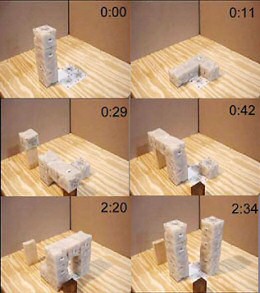13 May 2005
No Sex Please, We're Robots
by Kate Melville
 One of science fiction's scariest ideas - the out-of-control von Neumann machine - has been realized, albeit on a simple level. A report in Nature says that Cornell University researchers have created a machine that can build copies of itself. The researchers admit that the machine is just a proof of concept - it performs no useful function except to self-replicate - but they say the basic principle could be extended to create robots that could replicate or at least repair themselves while working in space or other hazardous environments.
One of science fiction's scariest ideas - the out-of-control von Neumann machine - has been realized, albeit on a simple level. A report in Nature says that Cornell University researchers have created a machine that can build copies of itself. The researchers admit that the machine is just a proof of concept - it performs no useful function except to self-replicate - but they say the basic principle could be extended to create robots that could replicate or at least repair themselves while working in space or other hazardous environments.
The robots are made up of a series of modular cubes, each containing identical machinery and the complete computer program for replication. The cubes have electromagnets on their faces that allow them to selectively attach to and detach from one another. A complete robot consists of several cubes linked together. Each cube is divided in half along a long diagonal, which allows a robot composed of many cubes to bend, reconfigure and manipulate other cubes. A tower of cubes, for example, can bend itself over at a right angle to pick up another cube. To begin replication, the stack of cubes bends over and sets its top cube on the table. Then it bends to one side or another to pick up a new cube and deposit it on top of the first. By repeating the process, one robot made up of a stack of cubes can create another just like itself.
Self-replicating machines have been the subject of theoretical discussion since the early days of computing and robotics, but only two physical devices that can replicate have been reported. One uses Lego parts assembled in a two-dimensional pattern by moving along tracks; another uses an arrangement of wooden tiles that tumble into a new arrangement when given a shove. Exactly what qualifies as "self-replication" is open to discussion, researcher Hod Lipson of Cornell, points out. "It is not just a binary property - of whether something self-replicates or not, but rather a continuum," he explains. Human beings reproduce but don't literally self-replicate, since the offspring are not exact copies, said the researchers. And in many cases, the ability to replicate depends on the environment. Rabbits are good replicators in the forest, poor replicators in a desert and abysmal replicators in deep space, they note. "It is not enough to simply say they replicate or even that they replicate well, because these statements only hold in certain contexts," the researchers said.
The new robots in Lipson's lab are very dependent on their environment as they draw power through contacts on the surface of the table and cannot replicate unless the experimenters "feed" them by supplying additional modules. "Although the machines we have created are still simple compared with biological self-reproduction, they demonstrate that mechanical self-reproduction is possible and not unique to biology," conclude the researchers.
(Pic courtesy of Cornell University)
Check out Hod Lipson's page on self-replication: http://www.mae.cornell.edu/ccsl/research/selfrep/
